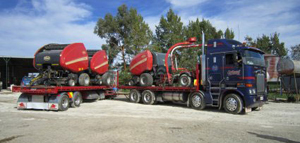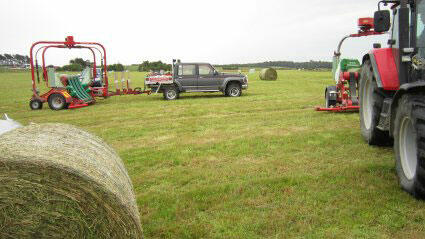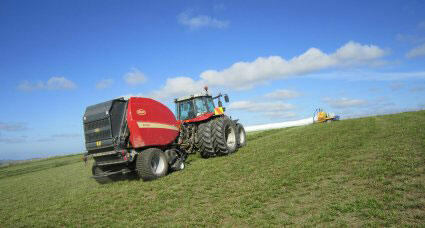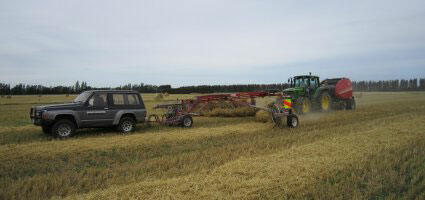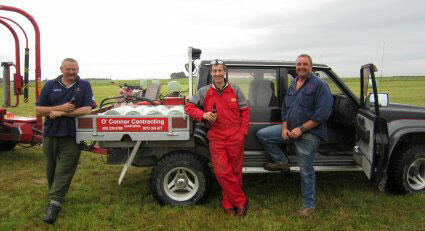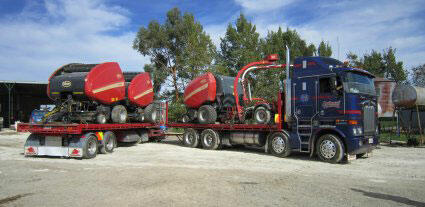Tim Baker, Vicon UK technical manager, travels to New Zealand to follow the new baler range as it gains valuable in-field evaluation ahead of the 2011 European grass harvest season.
|
|
Pickup trucks – or Utes – are an economical way of operating wrappers and rakes. |
Immediately following the successful launch of our new range of balers and wrappers in Italy last September, the team behind their introduction was keen to gain as much in-field experience as possible ahead of the 2011 European grass harvest season.
Three balers and a twin satellite wrapper were immediately shipped to New Zealand for testing and evaluation, and Tim Baker, Vicon UK technical manager, headed down-under to start the machines off and follow their progress.
One of the primary goals of this test programme was to develop and refine the industry-leading Kverneland Group Mechatronics control systems fitted to the new machines.
Steep slopes demanded dual wheels for added security. |
A wide variety of crop conditions were invaluable to test the machines capabilities. First stop, New Zealand’s South Island, and working out of Ashburton, just south of Christchurch on the Canterbury Plain (now famous for all the wrong reasons), the RV4216 baler took a variety of straw, ryegrass and silage crops in it’s stride.
Much of the land on the Canterbury Plain is irrigated and there is a huge amount of grass grown, for what has become an increasingly profitable dairy industry.
A recurring theme was the quality of the bales being produced, with compliments from many farmers about the consistency of bale diameter and uniform appearance of the bales.
One customer said he had never before had bales with such a consistent diameter and was very pleased when the RV returned again a few days later to bale another of his crops.
V-rake behind a Ute prepares a dense straw swath for the RV baler. |
A distinct feature of baling in New Zealand is the widespread use of Acrobat-type finger wheel rakes. These are commonly pulled by a Ute equipped with a hydraulic power pack. It is a cost effective solution, though the quality of the swath often left a lot to be desired – though it proved no problem for our balers.
In this central area, most bales are wrapped by tubeliners, which are favoured for their economic use of film.
Testing further south at Omaru, the countryside was much more rolling with dual wheels on tractors giving added security on steeper slopes.
With an obvious focus on baling silage, the RF3325 and BW2850 wrapper were located at the southernmost tip of the South Island at Invercargill. Predominantly a grass area with reasonable numbers of sheep, it is the burgeoning dairy industry that once again holds the upper hand.
Bale quality once again was impressive, with highly competitive bale weights being produced and the benefit of the five-tine bar pick-up really being seen - particularly in the late season silage crops.
Intake capacity, ease of loading net and a low power requirement were all subject to positive comment.
Another field done, and its time for a cold one. |
The BW2850 twin satellite wrapper gained valuable experience working with a contractor who had made 65,000 bales in three seasons with his previous generation wrapper. Once again the ubiquitous ‘Ute’ comes into play, being a low cost alternative to a tractor on a job requiring very little power, while also offering a much higher transport speed.
With their really friendly and helpful attitude, the Kiwi contractors involved in the evaluation and testing programme helped us to make a huge amount of progress in a short space of time. But they also made the process an enjoyable one.
Myself and Kv UK service manager Mike Howell - who also spent time in New Zealand on the programme - are looking forward to getting these new machines working in the UK grass season, secure in the knowledge that valuable lessons learnt from this testing schedule have already been fully integrated into all 2011 production models.
And those evaluation machines? They’re now in a container heading back to the UK to rack-up another season’s heavy workload.
Kenworth prepares to haul test machines to the docks for their return to the UK to continue with in-field evaluation. |
30.05.2011
